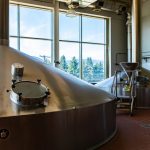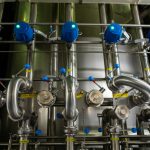
Clarifying beer is essential if the product is to be enjoyed by the consumer. What are the key processes involved?
A Short Overview Of The Brewing Process
Any brewer will explain that the conventional method of brewing is to steep malt in hot water to produce a thick, sweet syrupy liquid called wort. The wort is passed to the wort boiler where it is brewed and boiled for up to 2 hours. It is then clarified and allowed to cool. Yeast is added to the cooled wort where it is then fermented in tanks. The yeast converts grain sugar in the wort to alcohol and so beer is created. Beer is often clarified using fine-filters and then pasteurised before transferred to bright beer tanks. It will often be carbonated in this type of tank. Beer dealcoholization involves removal of the alcohol before clarification.
Beer Clarification
Beer clarification is essential when producing a high quality product. When a fermentation has completed, the beer will now contain yeasts as cells, colloidal particles of protein-tannin complexes, various pieces of insoluble material and other debris from wort boiling, other particulates of insoluble material which have been generated by the change in pH and any cold temperature conditioning during the ageing process.
The yeast after fermentation settles at the bottom of the tank. These are often referred to as settled tank bottoms and make up between 1.5 and 2% of the total beer volume. The yeast is valuable for reuse as pitching yeast or in extract production but there is also some beer which would be lost. The beer is recovered and the yeast concentrated by up to 20% dry weight using either dead-end filtration or a continuous membrane process based conventionally on microfiltration with plate-and-frame modules or with tubular systems.
Producing Bright Beer
Further clarification is often needed to remove the insoluble particulates so that the beer is successfully stabilised.
Beer is one product that benefits from filtration as a means of generating a crystal-clear liquid. Beer following fermentation not only contains spent yeast particles but a great deal of suspended proteinaceous material. This is hazy or rough beer. The particle size of most of the suspended material in beer is between 0.5 and 4 microns. Knowing the lower size limit of the particles to be removed is critical in designing an appropriate membrane process.
Four clarification methods are used separately or in combination.
Three filtration mechanisms or processes are considered in beer filtration (1) surface (2) depth filtration based on mechanical removal of particulates and (3) depth filtration based on the adsorption of particles.
A surface filtration process relies on particles being blocked at the surface of the filtration system – cross-flow membranes systems are ideal here.
With cider, treatment is more successful because the temperature of processing which is typically 30 Cent. means fouling is less severe and a better quality product is obtained. The yeasts is also usually concentrated to 20% dry weight solids so that it is then reused in cider fermentation.
Some breweries use CFMF to pasteurise clarified beer
A ceramic membrane system is ideal – a 1.4 micron pore size membrane will retain yeasts without necessarily also retaining important proteins and polyphenols (Fillaudeau & Carrere, 2002).
Fouling is always due to a yeast cell layer which is sensitive to cross-flow velocity. If tighter membranes of 0.1 micron, 0.45 and 0,8 microns are used the retention or adsorption of clarified beer components such as protein and polyphenols predominates. Rough and clarified beer fouling are apparently similar – it is the yeast cells that reduce the compactness of fouling proteins and polyphenols.
Various methods have been tried to improve cross-flow filtration such as modifying the bulk feed flow hydrodynamic conditions by usually imposing a helical-flow pattern and a two-way reversing flow pulsation.
References
Fillaudeau, L., & Carrère, H. (2002). Yeast cells, beer composition and mean pore diameter impacts on fouling and retention during cross-flow filtration of beer with ceramic membranes. Journal of Membrane Science, 196(1), pp. 39-57 (Article)


Leave a Reply